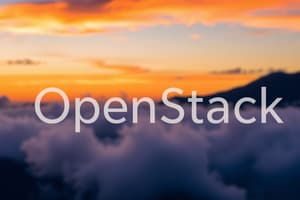Podcast
Questions and Answers
Qu'est-ce que l'auto-guérison dans OpenStack?
Qu'est-ce que l'auto-guérison dans OpenStack?
- La capacité du système à détecter et récupérer automatiquement des pannes (correct)
- La gestion manuelle des pannes dans OpenStack
- Le processus de redémarrage manuel du système après une panne
- L'installation de nouvelles fonctionnalités dans OpenStack
Quel est le rôle de la surveillance dans OpenStack?
Quel est le rôle de la surveillance dans OpenStack?
- Définir de nouveaux protocoles de sécurité
- Analyser les performances du système après une panne
- Assurer la réparation manuelle des pannes
- Identifier les problèmes potentiels tôt pour une intervention rapide (correct)
Que signifie l'auto-scaling dans le contexte d'OpenStack?
Que signifie l'auto-scaling dans le contexte d'OpenStack?
- L'arrêt complet du système lorsqu'il n'est pas utilisé
- La nécessité d'une intervention humaine pour ajouter des ressources
- La limitation des ressources disponibles en tout temps
- L'ajustement automatique des ressources en fonction de la demande (correct)
Quel est l'avantage de l'automatisation de la guérison dans OpenStack?
Quel est l'avantage de l'automatisation de la guérison dans OpenStack?
Que comprend l'automatisation en boucle fermée dans OpenStack?
Que comprend l'automatisation en boucle fermée dans OpenStack?
Quelle est la fonction principale du redimensionnement automatique dans OpenStack?
Quelle est la fonction principale du redimensionnement automatique dans OpenStack?
Quel est l'un des avantages de l'orchestration d'auto-guérison dans OpenStack?
Quel est l'un des avantages de l'orchestration d'auto-guérison dans OpenStack?
Comment OpenStack assure-t-il une expérience utilisateur améliorée?
Comment OpenStack assure-t-il une expérience utilisateur améliorée?
Quel est l'un des exemples d'implémentation réussie d'OpenStack?
Quel est l'un des exemples d'implémentation réussie d'OpenStack?
Comment OpenStack gère-t-il les problèmes potentiels avant qu'ils n'affectent les utilisateurs?
Comment OpenStack gère-t-il les problèmes potentiels avant qu'ils n'affectent les utilisateurs?
Quel est l'avantage de l'intégration d'OpenStack avec d'autres outils et services?
Quel est l'avantage de l'intégration d'OpenStack avec d'autres outils et services?
Comment les fonctionnalités d'auto-guérison dans OpenStack assurent-elles une utilisation efficace des ressources?
Comment les fonctionnalités d'auto-guérison dans OpenStack assurent-elles une utilisation efficace des ressources?
Flashcards are hidden until you start studying
Study Notes
Self-Healing Orchestration in OpenStack
OpenStack, the leading open-source cloud computing platform, offers built-in self-healing features to help manage and maintain complex IT environments. Self-healing in OpenStack refers to the system's ability to automatically detect and recover from failures, ensuring continuous availability and stability. This not only saves time and effort but also helps improve overall reliability and uptime.
Key Components of Self-Healing Orchestration in OpenStack
-
Monitoring: OpenStack includes robust monitoring tools that can track system performance and health. These tools help in identifying potential issues early, allowing for prompt intervention and problem resolution.
-
Auto-Scaling: OpenStack supports automatic scaling of resources based on usage demands. When the demand increases, the system can scale up automatically, adding more resources as required. Similarly, when the demand decreases, OpenStack can scale down, removing excess resources. This helps ensure optimal resource utilization and prevents overloading the system.
-
Automated Healing: OpenStack includes automated healing features that can detect and resolve issues without human intervention. For instance, if there is a failure in a service within OpenStack, the system can automatically restart the service based on predefined rules.
-
Closed Loop Automation: OpenStack supports closed loop automation, which involves continuous monitoring, assessment, and adjustment. This allows the system to proactively address potential problems before they affect users, ensuring a smooth experience.
-
Integration with Other Tools: OpenStack integrates with other tools and services to provide a more robust self-healing environment. For example, it can integrate with Dynatrace for issue detection and resolution, and with ServiceNow for ticket management.
Benefits of Self-Healing Orchestration in OpenStack
-
Increased Reliability: By identifying and resolving issues automatically, self-healing orchestration in OpenStack helps ensure continuous availability and reduces downtime. This leads to better business continuity and improved user experiences.
-
Reduced Operational Costs: Automating recovery processes can save time and resources that would otherwise be spent on manual resolution of issues. It also helps prevent the need for costly hardware upgrades by optimizing resource utilization.
-
Efficient Use of Resources: Self-healing features in OpenStack allow for resource optimization, ensuring that resources are allocated effectively based on current needs while minimizing waste.
Implementation Examples in OpenStack
OpenStack has been successfully implemented in various self-healing scenarios, including:
- Predictive Resource Scaling: Using historical data, AI algorithms predict peak demand periods, automatically provisioning additional resources to maintain optimal performance during surges without human intervention.
- Automated Workflow Adjustments: In case a process encounters an issue, AI-driven workflows automatically restart or adjust processes, notifying relevant personnel for seamless problem resolution.
- Proactive Issue Resolution: Leveraging machine learning on historical data, self-healing environments proactively identify potential issues before they impact operations, allowing for timely remediation.
- Continuous System Optimization: AI-driven self-healing continuously assesses system health and performance, automating changes and upgrades to optimize operations and enhance end-user experiences.
In conclusion, self-healing orchestration in OpenStack is a crucial aspect for managing complex IT infrastructure. By leveraging monitoring, auto-scaling, automated healing, closed loop automation, and integration with other tools, OpenStack provides a robust solution for maintaining reliable and efficient cloud services.
Studying That Suits You
Use AI to generate personalized quizzes and flashcards to suit your learning preferences.




